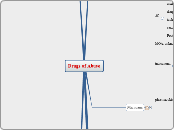Drugs of Abuse
Sedative-Hypnotics
act at GABA-A receptor complex
Incr Cl conductance
Alcohols
Ethanol
Actions
Acute
vasodilation and decr HR
CNS
low dose
neuronal disinhibition (behavioral stimulation)
moderate dose
neuronal inhibition (CNS depression)
high dose
more severe CNS depression (coma, death)
Diuresis
n/v
Chronic
thiamine deficiency
peripheral neuropathy
Wernicke's encephalopathy
Korsakoff's syndrome
incr NADH/NAD ratio
cirrhosis
pancreatitis
precipitates DM
cardiomyopathy
cancer
FAS
Contraindications
ulcers
liver disease
pregnancy
seizure d/o
Drug interactions
other sedatives (BZ, Antidepress., Antihistam.)
aspirin, other NSAIDS
GI bleeding
phentoin and warfarin
Acute EtOH
inhibs liver microsomal enzymes
decr metab
Chronic EtOH
induces liver microsomal enzymes
incr metab
Drug therapy
causes you to feel bad symptoms earlier
Disulfram
chelates the cofactors necessary for acetaldehyde DH
causes "acetaldehyde syndrome"
n/v
flushing
HA
sweating
hypotension
confusion
reduces craving
Naltrexone
opioid recptor antag
reduces craving and prevents relapse
Acamprosate
competitive inhib of NMDA Glutamate receptor
Methanol
Poisoning
Blindness
Acidosis
Seizures, coma
Tx
Ethanol administration
Incr frequency of Cl channel opening
Benzodiazepines
Chloridiazepoxide
Incr duration of Cl channel opening
Barbituates
ultrashort acting
Thiopental
highly lipid soluble
general anesthesia
short-intermediate acting
Pentobarbital
preanesthetic
regional anesthesia
less lipid soluble
long acting
Phenobarbital
less lipid soluble
25% excreted unchanged
duration of action influenced by pH of urine
uses:
seizure d/o
withdrawal syndrome from sed/hyp's
congenital hyperbilirubinemia
neonatal jaundice
contraindications:
acute intermittent porphyria
much more risk for abuse than BZ's!!
Stimulants
short t1/2
Cocaine
blocks DA transporters/reuptake sites
metab to benzoylecgonine and ecgonine methlyester
indications:
topical anesthesia
toxicity:
perferation of nasal septum
"Crack Baby"
Seizures
Cerebrovascular hemorrhage
Coronary vasospasm, Arrythmia, MI
Toxic psychosis
long t1/2
Amphetamine (Dexedrine)
increases release of DA
inhibits MAO (so NE builds up)
toxicity
necrotizing arteritis
see also "Cocaine: Toxicity"
indications:
Narcolepsy
ADHD
Amphetamine analogues
Methamphetamine (Desoxyn)
Methylphenidate (Ritalin)
Phenteramine (Adipex-P)
Acute Actions
euphoria
elevated mood
decreased appetite
increased motor activity
AE:
extraordinary tolerance can develop
anxiety, insomnia
dangerous, bizzare behavior
tachycardia and HTN
sexual d/f
Post spree crash, withdrawal
Marijuana
MOA: unknown
indications:
prevent n/v during chemo
appetite stimulant in AIDS
decrease IOP in glaucoma
neuropathic pain
pharmacokinetics
rapidly absorbed in lungs
rapidly distributed to CNS
onset of action almost immediate
duration of action 2-3 hrs
high lipid solubility so sequestered and slowly metabolized
actions:
increased appetite
relaxed, dreamlike state
depersonalization
reddening of the conjunctiva
AE:
chronic lung effects (similar to nicotine)
"antimotivational syndrome" (controversial)
tolerance develops but disappears rapidly
Hallucinogens
indoleamine hallucinogens (serotonin-like)
Lysergic Acid Diethylamide (LSD)
extreme tolerance develops rapidly
5HT agonist
anesthetic hallucinogens
Phencyclidine (PCP)
NMDA antag
long half-life (d/t enterohepatic circulation)
dissociates individuals from themselves
phenethylamine hallucinogens (NE/DA/Amphet-like)
Ecstasy (MDMA)
halucinogenic properties
from incr 5HT transmission
drug-reinforcing properties
from release of DA in brain-reward system
Opioids
(see "Opioid" map)
Inhalants
Industrial/Household Solvents
paint thinners
degreasers
solvents in glue
correction fluid
marker pen solvents
toluene
Aerosols
Fluorocarbons
Anesthetic gases
Nitrous oxide
found in whipped cream cannisters
Halothane
Organic nitrates
Amyl Nitrate
Nicotine
MOA
mimics Ach at cholinergic nicotinic receptors
increases the release of adrenal catecholamines
increases the release of neurotransmitters
ACh
NE
DA
5HT
Pharmacokinetics
rapidly absorbed and distributed
metabolized mostly in liver, but also in lungs
eliminated by the kidney
t1/2 = 2hrs
AE:
Cancer
Chronic bronchitis
COPD
Coronary artery dz
Peripheral vascular dz
Tolerance
develops rapidly
long-lasting
Psychological Dependence
Activates brain reward system
Decr. MAO activity
Incr NO production
Incr. DA levels in nucleus accumbens
Withdrawal
High relapse rate
Treatment for Dependence
Replacement Therapies
Nicotine polacrilex (gum)
Nicotine transdermal patch
Nicotine nasal spray
Nicotine inhaler
Non-Nicotine Therapies
Clonidine
Alpha adrenoreceptor partial ag
Nortryptyline
Antidepressant
Bupropion (Zyban)
Antidepressant
Selegeline
MAO inhibitor
